To illuminate a cathedral ceiling effectively, one must consider layering light, using ambient, task, and accent zones. Selecting fixtures that harmonize with room size enhances functionality and aesthetic appeal. Highlighting architectural features with uplighting and spotlights adds depth and character. Incorporating smart technology allows for personalized control, while energy-efficient LED bulbs minimize maintenance. A cohesive aesthetic ties the space together, ensuring comfort. For additional insights on achieving the perfect illumination, one should explore further strategies.
Key Takeaways
- Layer lighting with ambient, task, and accent fixtures to create depth and highlight the cathedral ceiling’s beauty.
- Choose appropriately sized fixtures, ensuring they complement the room while providing effective light distribution.
- Use uplighting to accentuate the height of beams and spotlights for intricate details in moldings or artwork.
- Integrate smart technology for customizable brightness and ease of control to suit different activities or moods.
- Opt for LED bulbs and low-maintenance fixtures for longevity and easy upkeep in hard-to-reach areas.
Layering Light for Depth and Function
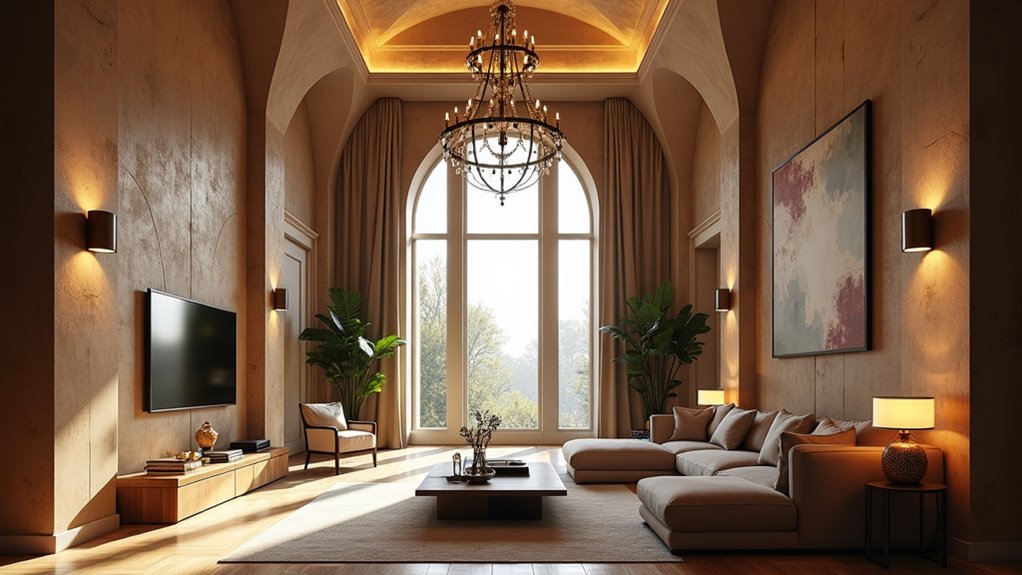
Lighting a living room with a cathedral ceiling demands a thoughtful approach to layering light, transforming the space into a dynamic and functional environment. This involves achieving ambient brightness through a foundational layer that includes fixtures such as recessed lights or dramatic chandeliers, effectively eliminating a cave-like atmosphere. Layered lighting adds depth and dimension, creating a more engaging atmosphere that reflects the beauty of the ceiling. Complementing this, task zones should be clearly delineated with focused illumination from floor or desk lamps, catering to activities like reading or working. Furthermore, accent lighting can draw attention to architectural features, enhancing the perceived height of the ceiling. It’s also important to keep in mind that network considerations can impact lighting fixtures if they rely on smart technology connected to the internet.
Choosing Appropriate Fixtures
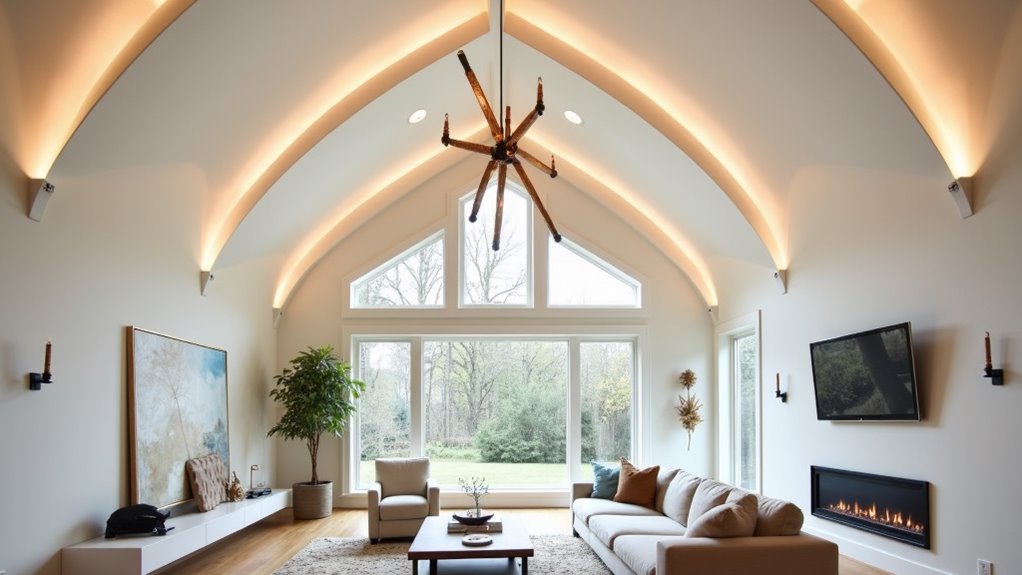
Selecting the right fixtures for a cathedral ceiling requires careful consideration of scale and functionality.
The size of each fixture should harmonize with the room’s vastness, while versatile recessed lighting can ensure an even distribution of light without overwhelming the space.
Additionally, track lighting offers an adaptable solution, allowing homeowners to highlight architectural elements or create layered lighting effects throughout the area.
Proportionate Fixture Size
Finding the right balance in fixture size transforms a living room into a harmonious space, especially when dealing with cathedral ceilings. Scaling the fixture appropriately involves more than mere dimensions; it encompasses fixture shape and visual weight. The formula for diameter anchors the design, inviting fixtures that match the room’s length and width.
High ceilings necessitate larger fixtures; thus, a chandelier or an oversized pendant can command the vertical expanse without overwhelming it. Additionally, intricate designs may create a visual illusion of size, prompting a subtle reduction in width.
Ensuring at least seven feet of clearance reinforces practicality, safeguarding movement while amplifying aesthetic impact, thus solidifying the fixture’s role as a centerpiece, complementing the grandeur of the cathedral ceiling.
Versatile Recessed Lighting
Creating an inviting atmosphere in a living room with cathedral ceilings necessitates thoughtful consideration of lighting fixtures, particularly recessed options that adapt seamlessly to the architectural nuances.
When selecting fixtures, homeowners should consider:
- Adjustable Fixtures: Gimbal or eyeball lights that allow direct light to be aimed downwards.
- Angle-Cut Fixtures: Designed specifically for sloped ceilings, these ensure targeted illumination without glare.
- Wall Washers: Ideal for highlighting art or large vertical spaces by providing an even wash of light.
Integrating dimming options enhances the flexibility of these fixture styles, allowing for varying brightness levels to suit different moods and occasions.
Impact of Track Lighting
Track lighting serves as a transformative solution for illuminating the unique heights and angles of cathedral ceilings, elevating both functionality and aesthetics within the living space.
Its track versatility allows for fixtures to be easily repositioned, adapting to changes in interior layout or architectural focus.
Suspended systems can effectively bring illumination closer, while monorail tracks provide design freedom through their ability to bend and curve, creating distinctive patterns of light.
The selection of adjustable heads ensures precise light direction, balancing spotlight and floodlight options for layered illumination.
Highlighting Architectural Features
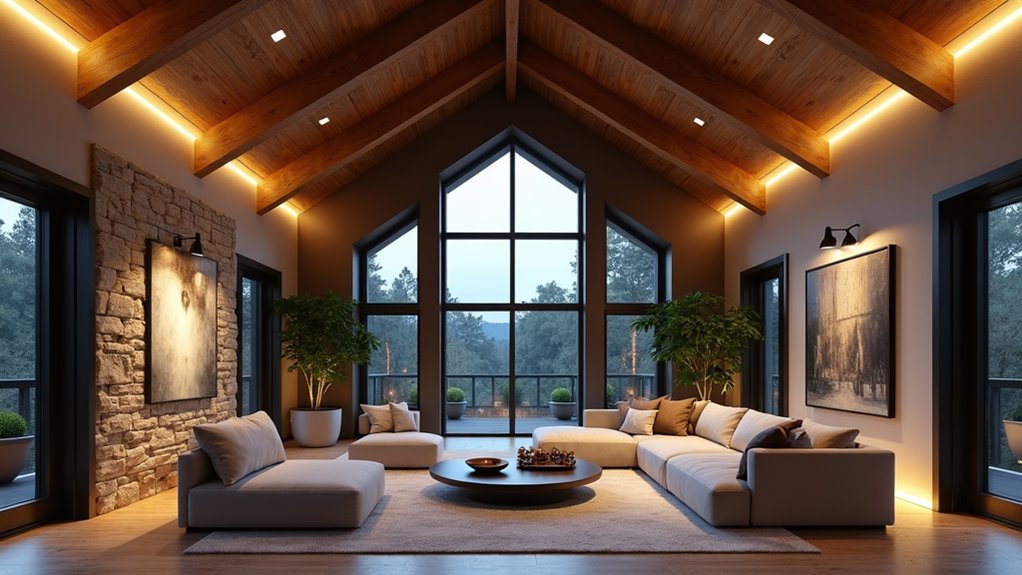
Highlighting architectural features in a living room with a cathedral ceiling can transform the space, creating a stunning interplay of light and structure.
By employing uplighting techniques, one can accentuate the height and details of beams, while strategically positioned spotlights draw the eye towards intricate moldings and artwork.
This careful orchestration of light not only enhances each element but also establishes a harmonious ambiance throughout the room.
Uplighting Techniques
Uplighting, a technique that transforms the ambiance of a living room, serves as a powerful tool for showcasing the intricate architectural features of cathedral ceilings. By utilizing indirect lighting, it highlights the height and unique angles of these ceilings while minimizing harsh shadows.
To effectively use uplighting for architectural emphasis, consider the following strategies:
- Fixture Selection: Utilize wall sconces or floor-standing uplights to enhance specific features.
- Placement: Position uplights at the base of columns or along exposed beams to draw attention to their textures.
- Lighting Color: Choose warm tones to complement the room’s decor, creating a welcoming atmosphere.
This thoughtful approach adds depth and enhances the overall elegance of the living space.
Directional Spotlighting Options
Illuminating the unique characteristics of a cathedral ceiling requires strategic use of directional spotlighting options that enhance architectural beauty. Monopoint spotlights offer a precise focus, allowing homeowners to direct light onto specific features, such as intricate beams or angles. Their adjustable nature provides versatility, ideal for creating layered lighting effects.
Wall-mounted sconces serve a complementary function, drawing attention to artwork and architectural details while bridging the visual gap between floor and ceiling. These sconces can wash walls with soft light or graze textures, eliminating shadows and enhancing dimension.
Together, these lighting techniques transform a spacious cathedral ceiling into an enticing focal point, accentuating its grandeur while maintaining a harmonious ambiance within the living room.
Strategic Placement and Installation
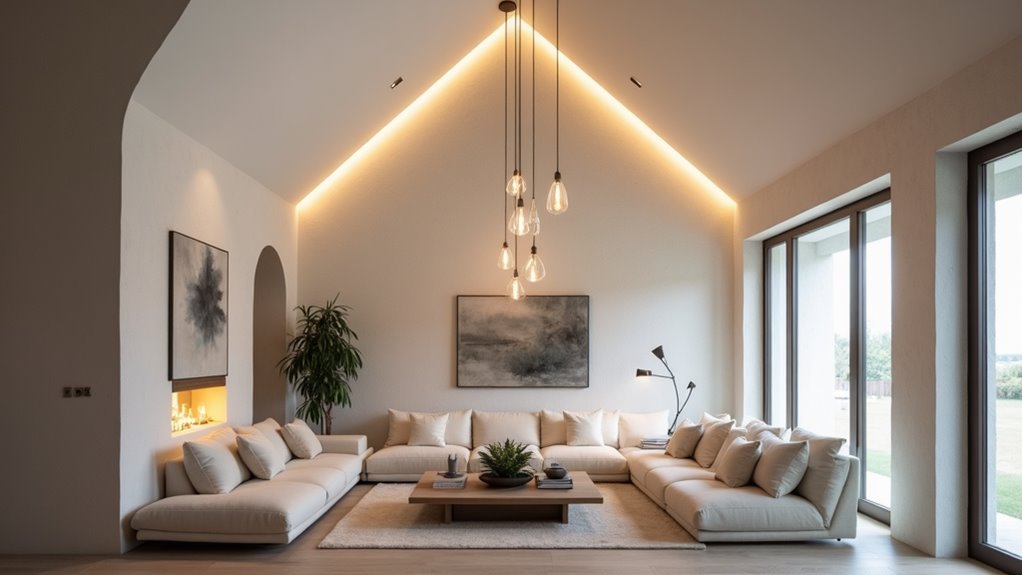
Strategically placing and installing lighting fixtures in a cathedral ceiling living room often transforms the space into an inviting and dynamic environment.
Strategic lighting transforms a cathedral ceiling living room into an inviting and dynamic space.
An effective fixture arrangement involves thoughtful light layering that combines ambient, task, and accent lighting. To achieve balanced illumination, consider the following:
- Position recessed lights evenly across the ceiling, spaced 4-6ft apart and at least 3ft from walls to minimize shadows.
- Install pendant lights at varying lengths to draw the eye upward, enriching the vertical space.
- Utilize wall-mounted fixtures to highlight artwork or architectural features, enhancing the room’s depth and character.
Employing these strategic placements not only enhances functionality but also elevates the overall aesthetic of the living room.
Incorporating Controls and Technology
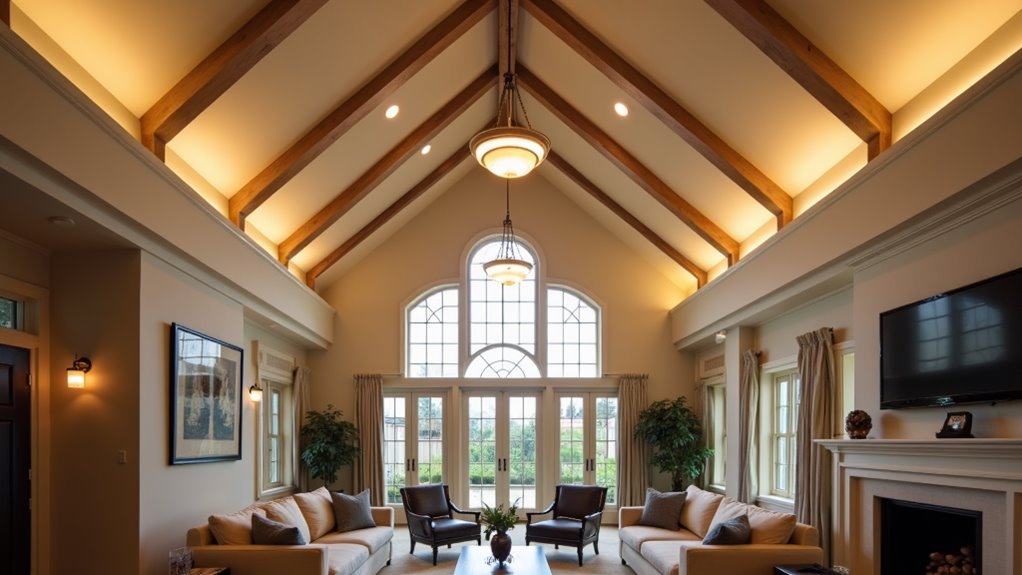
How can modern technology elevate the lighting experience in a cathedral ceiling living room?
Integrating smart technology is key, providing automation options that transform ambiance at the touch of a button or through voice control. Programmable settings allow homeowners to customize brightness and color temperature, ensuring the perfect atmosphere for any occasion.
Intelligent dimmers enhance versatility, adapting to activities and time of day with ease. Wireless connectivity facilitates seamless integration with smart home systems like Google Home or Amazon Alexa, enabling hands-free operation.
Additionally, motion and light sensors can automatically adjust lighting based on occupancy or natural light availability, offering an innovative solution to managing high ceilings effortlessly. This blend of functionality and convenience redefines modern living.
Emphasizing Energy Efficiency and Maintenance
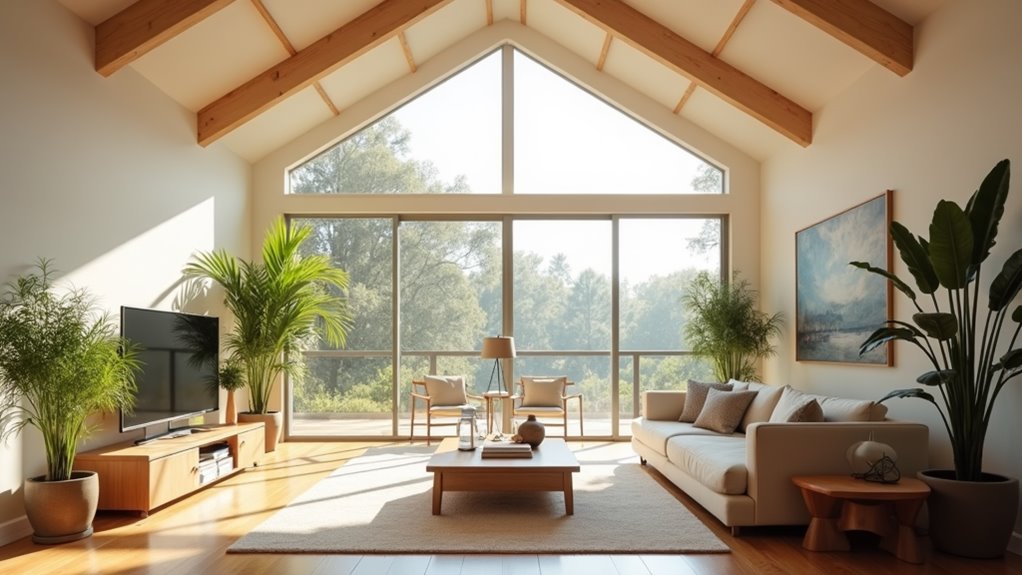
The integration of smart technology within a cathedral ceiling living room not only enhances user experience but also invites a thoughtful consideration of energy efficiency and maintenance practices.
Prioritizing LED technology can yield significant energy savings while minimizing upkeep. Here are essential maintenance tips:
- Choose LED Bulbs: With lifespans of 25,000-50,000 hours, they reduce frequent replacements in hard-to-reach areas.
- Opt for Low-Maintenance Fixtures: Select smooth-surfaced designs to ease dust removal and regular cleaning.
- Plan Accessibility: Consider motorized lifts for high fixtures, ensuring easy access for bulb changes and cleaning tasks.
Implementing these strategies allows homeowners to enjoy aesthetic brilliance while reducing energy consumption and maintenance efforts in their living rooms.
Creating a Cohesive Aesthetic
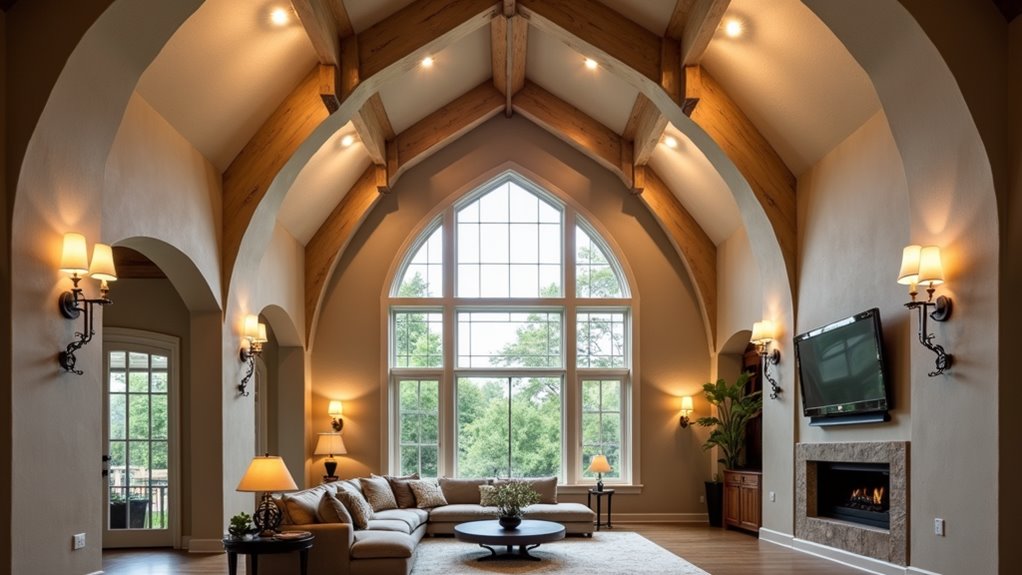
While creating a cohesive aesthetic in a living room with a cathedral ceiling, attention to detail is paramount. A balanced approach to color coordination and texture balance is essential for unifying the space.
Selecting lighting fixtures that share design elements and finishes fosters harmony; this becomes even more impactful when these fixtures echo the room’s overall aesthetic. Layering lighting through ambient, task, and accent sources adds depth and highlights architectural features. Positioning lights thoughtfully ensures even distribution and emphasizes the ceiling’s height.
Additionally, integrating lighting with furniture and decor elements enhances visual flow, allowing the room’s personality to shine. Ultimately, a cohesive lighting design not only beautifies but also enhances the comfortable atmosphere crucial in high-ceilinged spaces.


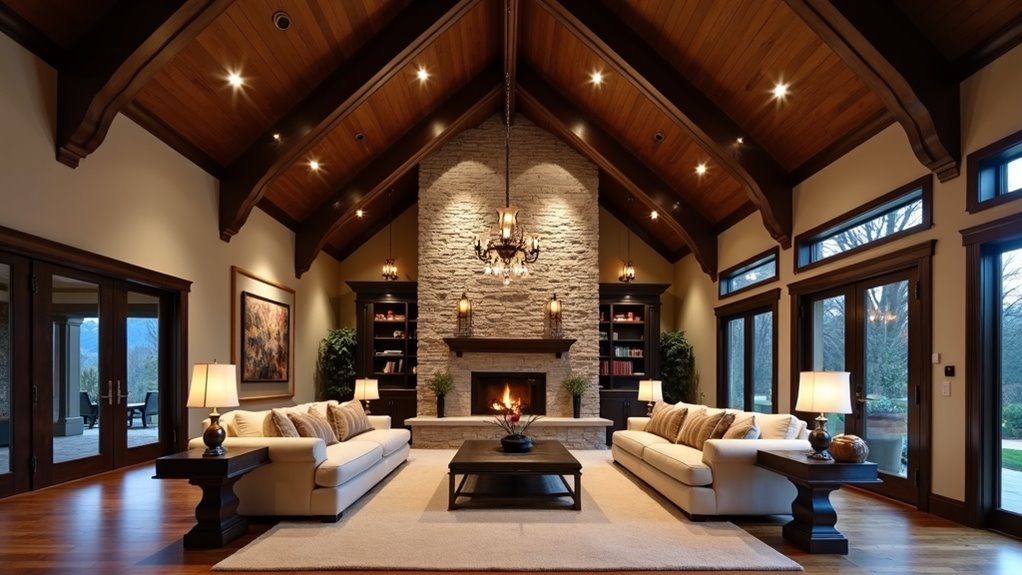
Bài viết cùng chủ đề:
7 Brilliant Living Room Lighting Design Ideas
10 Essential Living Room Lighting Trends for 2025
Top 5 Living Room Track Lighting Fixtures for Modern Homes
7 Tips for Creating Stunning Living Room Cove Lighting Designs
3 Brilliant Ideas for Living Room Floor Lighting
7 Tips for Perfect Living Room Ceiling Recessed Lighting